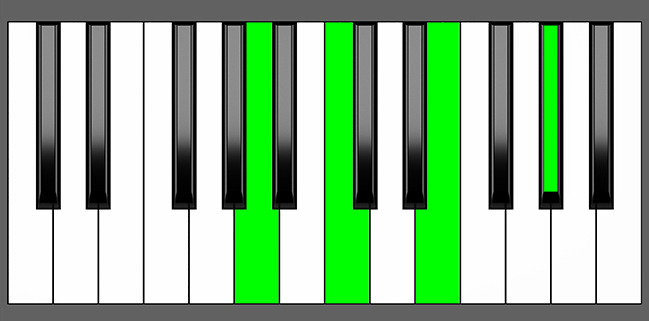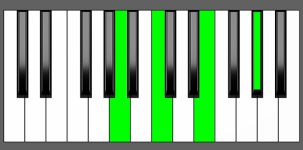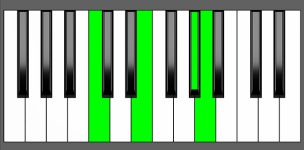Piano Diagram of AmMaj7 in Root Position

The AmMaj7 chord is a minor chord rooted in the key of A, consisting of the notes A, C, E, and G#. The main feature of this chord is the inclusion of a major 7th interval on a minor chord. Additionally, the presence of an augmented fifth between the minor 3rd and major 7th creates a sense of dissonance. In this article, we will delve into the music theory of the AmMaj7 chord and its role within chord progressions.
Structure of AmMaj7
Notes |
|---|
| A, C, E, G# |
Intervals |
|---|
| R, m3, 5, 7 |
Finger Position
Left Hand |
|---|
| 5, 3, 2, 1
5, 4, 2, 1 |
Right Hand |
|---|
| 1, 2, 4, 5
1, 2, 3, 4 |
AmMaj7 Chord Inversions
The AmMaj7 chord has a total of 3 inversions:
| Root Position: | A | C | E | G# |
| 1st Inversion: | C | E | G# | A |
| 2nd Inversion: | E | G# | A | C |
| 3rd Inversion: | G# | A | C | E |
Piano Keyboard Diagrams
Music Theory and Harmony of AmMaj7
Building the AmMaj7 Chord: Different Approaches
Starting from the A Major Scale
An A minor major 7th chord is formed by taking the root note A, adding a minor 3rd interval (C), a perfect 5th interval (E), and finally a major 7th interval (G#). Although these intervals are typically derived from a minor scale, for educational purposes, it is often more intuitive to explain their construction using a major scale.
For example, to build an AmMaj7 chord, you can start with the A Major scale:


To create an AmMaj7 chord, apply the formula R, m3, 5, 7 in the following manner:
- Begin with the Root note, which is A.
- Select the minor 3rd interval, C.
- Include the 5th note, E.
- Finally, add the major 7th interval (G#), which is the 7th note of the scale.
By following this simple formula, you can create a minor major 7th chord from any major scale.
by Combining Intervals
A way to form a minor major 7th chord is by combining specific intervals – a minor 3rd, a major 3rd, and another major 3rd.
m3 + 3 + 3 = minor Major 7th chords
If we observe the intervals between the notes, we can notice that:
- A-C creates a minor 3rd interval,
- C-E forms a major 3rd interval,
- and E-G# is another major 3rd interval.
By stacking these three intervals together, we can build the AmMaj7 chord.
How to Use AmMaj7 in a Chord Progression
The AmMaj7 chord is characterized by the presence of a major 7th interval, which is not found in either the natural minor or major scales. It’s diatonic in other scales like the harmonic and melodic minor scale, which features a minor major seventh chord on their first degree.
Typically, the AmMaj7 chord is used as a passing chord, temporarily transitioning towards a more stable Am7. Additionally, it can serve as an ending chord in specific musical contexts. This is because the chord produces a mysterious and intriguing atmosphere, making it suitable for certain musical styles and compositions.
Non-diatonic positions in Natural minor and Major Scales
The major seventh interval of the AmMaj7 chord, which is G#, clashes with the G note present in both natural minor and major scales. For this reason, the AmMaj7 chord is not commonly used as a standalone chord (except in endings).
The AmMaj7 chord is commonly used:
- on the first and fourth degree of minor scales or
- on the second and on the sixth degree of major scales,
- as part of a chromatic progression towards a minor 7th chord.
- While less common, it can still be used on the fifth degree of both minor and major scales.
Here are the tables of the major and minor keys that include the A minor 7th, which can be complemented by an AmMaj7 chord.
on Natural minor Scales
| Minor Scales | i | ii | III | iv | v | VI | VII |
|---|---|---|---|---|---|---|---|
| A | A min7 ⇒ AmMaj7 |
Bm7b5 | C Maj7 | D min7 | E min7 | F Maj7 | G7 |
| E | E min7 | F#m7b5 | G Maj7 | A min7 ⇒ AmMaj7 |
B min7 | C Maj7 | D7 |
| D | D min7 | Em7b5 | F Maj7 | G min7 | A min7 ⇒ AmMaj7 | Bb Maj7 | C7 |
Non diatonic passing chord to the:
- Tonic chord in A minor
- Subdominant chord in E minor
- Dominant chord in D minor (less common)
on Major Scales
| Major Scales | I | ii | iii | IV | V | vi | vii |
|---|---|---|---|---|---|---|---|
| G | G Maj7 | A min7 ⇒ AmMaj7 | B min7 | C Maj7 | D7 | E min7 | F#m7b5 |
| F | F Maj7 | G min7 | A min7 ⇒ AmMaj7 | Bb Maj7 | C7 | D min7 | Em7b5 |
| C | C Maj7 | D min7 | E min7 | F Maj7 | G7 | A min7 ⇒ AmMaj7 | Bm7b5 |
Non diatonic passing chord to the:
- Supertonic chord in G Major
- Mediant chord in F Major
- Submediant chord in C Major
AmMaj7 Function in Major and minor Keys
The chord AmMaj7 does not serve a functional role in harmonic progressions within major and minor keys as it is not diatonic. Rather, it should be considered as a color to add in certain contexts where modulation to an Am7 chord is feasible or appropriate.
AmMaj7 as Passing Chord in A minor
In the key of A minor, the AmMaj7 serves as a passing chord to the Tonic chord, Am7. The chord’s major 7th note, G#, clashes with the natural G note found in the A minor scale, creating a tension that needs to be resolved. This can be achieved by transitioning the chord to a more stable Am7 chord, which typically occurs within the same measure as the AmMaj7 chord.
Alternatively, the AmMaj7 chord can be left alone as an ending chord, but it’s too dissonant to be played for a whole measure within a chord progression.
| i | ii | III | iv | v | VI | VII |
| A min7 | Bm7b5 | C Maj7 | D min7 | E min7 | F Maj7 | G7 |
Am(Maj7) as Passing Chord on the i degree
The following chord progressions are examples of how the A minor major 7th chord can serve as a passing chord towards the tonic chord (Am7).
Chromatic modulation
| i | iΔ | i7 | i6 |
| A min
(A, C, E, A) |
AmMaj7
(A, C, E, G#) |
Am7
(A, C, E, G) |
A min6
(A, C, E, F#) |
i VI VII III
| i | VI | VII | III |
| Am9 | Am7 | AmMaj7 | Am7 | F Maj7 | G7 | C Maj7 |
i iv VI VII
| i | iv | VI | VII |
| Am9 | Am7 | AmMaj7 | Am7 | D min7 | F Maj7 | G7 |
Circle Progression
| i | iv | VII | III | VI | ii | V7 | i |
| Am | AmMaj7 | Am7 | Am6 | D min7 | G7 | C Maj7 | F Maj7 | Bm7b5 | E7 | Am7 | AmMaj7 |
AmMaj7 as Passing Chord in E minor
The AmMaj7 chord can be used as a passing chord in the E minor scale which has an A min7 on the fourth degree.
| i | ii | III | iv | v | VI | VII |
| E min7 | F#m7b5 | G Maj7 | A min7 | B min7 | C Maj7 | D7 |
AmMaj7 as Passing Chord on the iv degree
The following chord progressions feature an AmMaj7 chord in modulation to the iv degree in the key of E minor:
iv III VI VII
| iv | III | VI | VII |
| Am9 | Am6 | AmMaj7 | Am6 | G Maj7 | C Maj7 | D7 |
i iv VI v
| i | iv | VI | v |
| E min7 | Am9 | Am6 | AmMaj7 | Am6 | C Maj7 | B min7 |
Circle Progression
| i | iv | VII | III | VI | ii | V7 | i |
| E min7 | Am7 | AmMaj7 | D7 | G Maj7 | C Maj7 | F#m7b5 | B7 | E min7 |
AmMaj7 as Passing Chord in D minor
In the D minor scale, the AmMaj7 chord can serve as a passing chord within the fifth degree, Am7.
| i | ii | III | iv | v | VI | VII |
| D min7 | Em7b5 | F Maj7 | G min7 | A min7 | Bb Maj7 | C7 |
AmMaj7 as Passing Chord on the v degree
i iv VI v
| i | iv | VI | v |
| D min7 | G min7 | Bb Maj7 | Am | AmMaj7 | Am9 | A min |
i v VI VII
| i | v | VI | VII |
| D min7 | Am | AmMaj7 | Am7 | Am6 | Bb Maj7 | C7 |
i VI v iv
| i | VI | v | iv |
| D min7 | Bb Maj7 | Am | AmMaj7 | Am7 | Am6 | G min7 |
AmMaj7 as Passing Chord in G Major
In the G major scale, the AmMaj7 chord can also serve as a passing chord on the ii degree.
| I | ii | iii | IV | V | vi | vii |
| G Maj7 | A min7 | B min7 | C Maj7 | D7 | E min7 | F#m7b5 |
AmMaj7 as Passing Chord on the ii degree
ii V I
| ii | V | I |
| Am7 | AmMaj7 | D7 | G Maj7 |
Circle Progression
| I | IV | vii | iii | vi | ii | V | I |
| G Maj7 | C Maj7 | F#m7b5 | Bm7 | E min7 | Am7 | AmMaj7 | D7 | G Maj7 |
AmMaj7 as Passing Chord in F Major
Another position where it could be possible to add some color modulating an Am7 is in the F major scale on the iii degree.
| I | ii | iii | IV | V | vi | vii |
| F Maj7 | G min7 | A min7 | Bb Maj7 | C7 | D min7 | Em7b5 |
AmMaj7 as Passing Chord on the iii degree
I iii IV V
| I | iii | IV | V |
| F Maj7 | Am9 | Am | AmMaj7 | Am | Bb Maj7 | C7 |
I iii ii V
| I | iii | ii | V |
| F Maj7 | Am | AmMaj7 | Am9 | Am | G min7 | C7 |
I iii vi IV
| I | iii | vi | IV |
| F Maj7 | Am9 | Am | AmMaj7 | Am | D min7 | Bb Maj7 |
AmMaj7 as Passing Chord in C Major
You can play the AmMaj7 in a modulation on the sixth degree of the C major scale.
| I | ii | iii | IV | V | vi | vii |
| C Maj7 | D min7 | E min7 | F Maj7 | G7 | A min7 | Bm7b5 |
AmMaj7 as Passing Chord on the vi degree
I iii vi V
| I | iii | vi | V |
| C Maj7 | E min7 | Am9 | Am | AmMaj7 | Am | G7 |
I vi ii V
| I | vi | ii | V |
| C Maj7 | Am9 | Am | AmMaj7 | Am | D min7 | G7 |
Circle Progression
| I | IV | vii | iii | vi | ii | V | I |
| C Maj7 | F Maj7 | Bm7b5 | Em7 | Am7 | AmMaj7 | D min7 | G7 | C Maj7 |
Alternative Names for AmMaj7
- A mΔ
- A mM
- A m7+
- A mΔ7
- A m(Δ)
- A mM7
- A minΔ
- A m(+7)
- A m(Δ7)
- A minΔ7
- A minorΔ
- A m(maj7)
- A m(Maj7)
- A minMaj7
- A min maj7
- A m(Maj7th)
- A minor major 7th
- A minor major seventh
Conclusion
The chord progressions and examples presented in this post provide a comprehensive overview of the most common uses of the AmMaj7 chord. It’s important to note, however, that there are many advanced harmony-related topics that could not be included due to space constraints. These topics include chord progressions built on harmonic and melodic scales, modal scales, hidden tonality, secondary dominants and other chord substitutions, non-functional harmony and atonal music, modal interchange and borrowed chords, voice leading and counterpoint, chromatisms, jazz harmony…I mean, music theory is a huge topic!
Although I couldn’t cover all of these topics in my post, I encourage readers to continue exploring these areas in their own study and research. By expanding your knowledge in these advanced areas of music theory, you can gain a deeper understanding of the harmonic possibilities that exist beyond the basics presented here.



